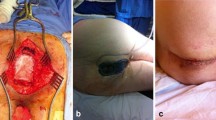Abstract
PURPOSE: This study was designed to compare the results of two methods on the rate of postoperative perineum healing. PATIENTS AND METHODS: In this prospective, randomized, multicenter trial of 234 consecutive patients undergoing abdominoperineal rectal excision for carcinoma, 48 had unsatisfactory hemostasis or intraoperative gross septic contamination. Three patients were withdrawn because of protocol violation. Of the 45 remaining patients, 21 were randomized to undergo primary closure of the perineum with drainage while 24 underwent packing. Preoperative factors (sex, age, degree of obesity, weight loss, anemia, or presence of ascites), intraoperative findings (Dukes stage, degree of hemostasis, gross septic contamination), and postoperative oncologic courses (recurrence, mortality rate) were similar in both groups. All patients were followed for at least 12 months or until their demise. RESULTS: There was no significant difference in the number of early (one vs. zero) or late (five vs. four) deaths between primary closure and packing groups, respectively. Median duration of hospital stay was 25 and 27 days, respectively. Primary closure was associated with a significantly higher rate of healed perineums at one month (30 percent vs. 0 percent) (P = 0.01) and a shorter delay to complete cicatrization (median, 47 vs. 69 days) (P < 0.01). From three months onward, there was no difference in healing between the two groups, but two patients in the packing group had not healed at one year. Conversely, hematoma, perineal abscess, and reoperations were significantly more frequent (P < 0.01) in the primary closure group. CONCLUSION: Primary closure associated with drainage after abdominoperineal resection for carcinoma expedites perineal healing but morbidity is higher.
Similar content being viewed by others
References
Irvin TT, Goligher JC. A controlled clinical trial of three different methods of perineal wound management following excision of the rectum. Br J Surg 1975;62:287–91.
Terranova O, Sandei F, Rebuffat C, Maruotti R, Pezzuoli G. Management of the perineal wound after rectal excision for neoplastic disease: a controlled clinical trial. Dis Colon Rectum 1979;22:228–33.
Robles Campos R, Garcia Ayllon J, Parrilla Paricio P,et al. Management of the perineal wound following abdominoperineal resection: prospective study of three methods. Br J Surg 1992;79:29–31.
Altemeier WA, Culbertson WR, Alexander JW, Sutorius D, Bossert J. Primary closure and healing of the perineal wound in abdominoperineal resection of the rectum for carcinoma. Am J Surg 1974;127:215–9.
Broader JH, Masselink BA, Oates GD, Alexander Williams J. Management of the pelvic space after proctectomy. Br J Surg 1974;61:94–7.
Baudot P, Keighley MR, Alexander Williams J. Perineal wound healing after proctectomy for carcinoma and inflammatory disease. Br J Surg 1980;67:275–6.
Marks CG, Monica Leighton, Ritchie JK, Hawley PR. Primary suture of the perineal wound following rectal excision for adenocarcinoma. Br J Surg 1976;63:322–6.
Maria G, Mattana C, Bonatti P, Pescatori M. Management of the perineal wound after rectal excision for carcinoma. Int Surg 1984;69:167–9.
Dencker H, Norryd C, Tranberg KG. Management of the perineal wound after rectal excision. Acta Chir Scand 1973;139:568–70.
Tompkins RG, Warshaw AL. Improved management of the perineal wound after proctectomy. Ann Surg 1985;202:760–5.
Hilsabeck JR. The presacral space as a collector of fluid accumulations following rectal anastomosis: tolerance of rectal anastomosis to closed suction pelvic drainage. Dis Colon Rectum 1982;25:680–4.
Galandiuk S, Fazio VW. Postoperative irrigation-suction drainage after pelvic colonic surgery: a prospective randomized trial. Dis Colon Rectum 1991;34:223–8.
Rodary M, Hay JM, Fingerhut A, Oberlin P, French Association for Surgical Research. Conventional mechanical preparation versus whole-gut irrigation for elective colonic resection. A multicentric prospective controlled trial. Coloproctology 1987;9:87–93.
French Association for Surgical Research, Rodary M, Fingerhut A, Hay JM. Mechanical and antibiotic preparation of the bowel for elective colorectal surgery. Three-day versus one-day preparation. Coloproctology 1988;10:271–6.
French Association for Surgical Research, Rodary M, Fingerhut A, Hay JM. Povidone-iodine enemas and one-day antibiotic prophylaxis: a continuous search for the ideal bowel preparation for elective colonie surgery, a multicentre controlled trial. Coloproctology 1991;13:5–12.
Cancer Research Campaign Working Party. Trials and tribulations: thoughts on the organization of multicentre clinical studies. BMJ 1980;281:918–20.
Waits JO, Dozois RR, Kelly KA. Primary closure and continuous irrigation of the perineal wound after proctectomy. Mayo Clin Proc 1982;57:185–8.
Mikulicz J. (Von)-Ueber die ausschaltung todter raüme aus der peritonealhöhle. Arch Klin Chir Berlin 1886;34:635–57.
Schwartz D, Flamant R, Lellouch J. Clinical trials. London: Academic Press, 1980.
Ruckley CV, Smith AN, Balfour TW. Perineal closure by omental graft. Surg Gynecol Obstet 1970;131:300–2.
Miles WE. Technique of the radical operation for cancer of the rectum. Br J Surg 1914;2:292–305.
Liebermann RC, Feldman S. Primary closure of the perineal wound with closed continuous transabdominal pelvic irrigation after rectal excision. Dis Colon Rectum 1984;27:526–8.
Hartz RS, Poticha SM, Shields TW. Healing of the perineal wound. Arch Surg 1980;115:471–4.
Alpsan K, Singh A, Ahmad A. Clinical comparison of perineal wound management. Dis Colon Rectum 1980;23:564–6.
Krook JE, Moertel CG, Gunderson LL,et al. Effective surgical adjuvant therapy for high-risk rectal carcinoma. N Engl J Med 1991;324:709–15.
Goligher JC. Surgery of the anus, rectum and colon. 4th ed. London: Ballière Tindall, 1980:399–401.
Baum ML, Anish DS, Chalmers TC, Sacks HS, Smith H, Fagerstrom RM. A survey of clinical trials on antibiotic prophylaxis in colon surgery: evidence against further use of no treatment controls. N Engl J Med 1981;305:795–9.
Rosen HR, Parczell AP, Czerwenka E, Stierer MO, Spoula H, Wals H. Local gentamicin application for perineal wound healing following abdominoperineal rectum excision. Am J Surg 1991;162:438–41.
Author information
Authors and Affiliations
Consortia
About this article
Cite this article
Delalande, JP., Hay, JM., Fingerhut, A. et al. Perineal wound management after abdominoperineal rectal excision for carcinoma with unsatisfactory hemostasis or gross septic contamination: Primary closure vs. packing. Dis Colon Rectum 37, 890–896 (1994). https://doi.org/10.1007/BF02052594
Issue Date:
DOI: https://doi.org/10.1007/BF02052594




